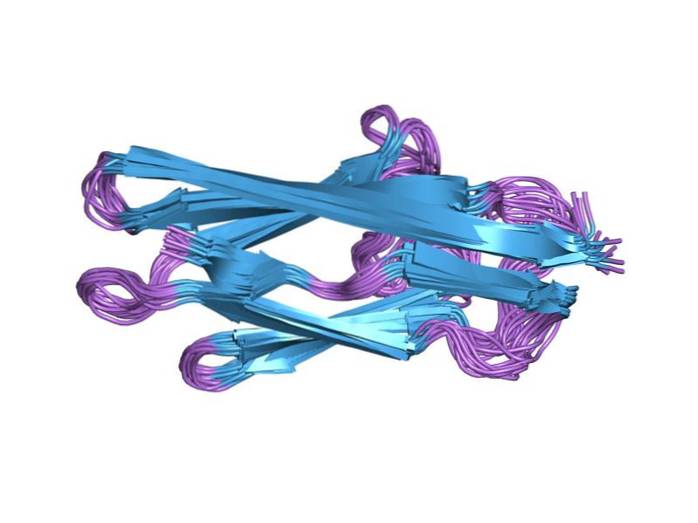
Titina structure, functions and related pathologies
Titina is the term used to describe a pair of giant polypeptide chains that make up the third most abundant protein in the sarcomeres of a wide range of skeletal and cardiac muscles.
Titin is one of the largest known proteins in terms of the number of amino acid residues and therefore in terms of molecular weight. This protein is also known as connectin and is present in both vertebrates and invertebrates.

It was described with this name (connectin) for the first time in 1977 and in 1979 it was defined as the double-band in the upper part of a polyacrylamide gel electrophoresis gel under denaturing conditions (with sodium dodecyl sulfate). In 1989 its location was established by immunoelectron microscopy.
Together with another large protein, nebulin, titin is one of the main components of the elastic network of the muscle cell cytoskeleton that coexists with the thick filaments (myosin) and the thin filaments (actin) within the sarcomeres; so much so that it is known as the third filament system of muscle fibers.
The thick and thin filaments are responsible for the generation of the active force, while the titin filaments determine the viscoelasticity of the sarcomeres..
A sarcomere is the repeating unit of myofibrils (muscle fibers). It is approximately 2μm long and is delimited by "plates" or lines called Z lines, which segment each myofibril into striated fragments of defined size.
Titin molecules assemble into extremely long, flexible, thin, and extensible filamentous strands. Titin is responsible for the elasticity of skeletal muscle and is believed to function as a molecular scaffold that specifies the correct assembly of sarcomeres in myofibrils..
Article index
- 1 Structure
- 2 Functions
- 2.1 Other functions
- 3 Related pathologies
- 4 References
Structure
In vertebrates, titin has about 27,000 amino acid residues and a molecular weight of around 3 MDa (3,000 kDa). It is composed of two polypeptide chains known as T1 and T2, which have similar chemical compositions and similar antigenic properties..
In the muscle of invertebrates are the "mini-titins”Of between 0.7 and 1.2MDa molecular weight. This group of proteins includes the protein "Twitchina" from Caenorhabditis elegans and protein "Projectin" found in genre Drosophila.
Vertebrate titin is a modular protein composed primarily of immunoglobulin and fibronectin III-like domains (FNIII-like) arranged in batch. It has an elastic region rich in proline, glutamic acid, valine and lysine residues known as the PEVK domain, and another serine kinase domain at its carboxyl terminal end..
Each of the domains is approximately 100 amino acids long and are known as class I titin (the fibronectin-like domain III) and class II titin (the immunoglobulin-like domain). Both domains fold into 4 nm long "sandwich" structures composed of antiparallel β-sheets..
The cardiac connectin molecule contains 132 repeat motifs of the immunoglobulin domain and 112 repeat motifs of the fibronectin III-like domain..
The coding gene for these proteins (TTN) is the "champion" of introns since it has almost 180 of these inside.
The transcripts of the subunits are differentially processed, especially the coding regions of the immunoglobulin (Ig) and PEVK-like domains, which give rise to isoforms with different extensible properties..
Features
The function of titin in sarcomeres depends on its association with different structures: its C-terminal end is anchored to the M line, while the N-terminal end of each titin is anchored to the Z line..
The nebulin and titin proteins act as "molecular rulers" that regulate the length of the thick and thin filaments, respectively. Titin, as mentioned, extends from the Z disk to beyond the M line, in the center of the sarcomere, and regulates its length, preventing overstretching of the muscle fiber..
It has been shown that the folding and unfolding of titin assists the muscle contraction process, that is, it generates the mechanical work that achieves the shortening or extension of the sarcomeres; while thick and thin fibers are the molecular motors of movement.
Titin participates in the maintenance of the thick filaments in the center of the sarcomere and its fibers are responsible for the generation of passive tension during the stretching of the sarcomeres..
Other functions
In addition to its participation in the generation of the viscoelastic force, titin has other functions, among which the following stand out:
-Participation in mechano-chemical signaling events through its association with other sarcomeric and non-sarcomeric proteins
-Length-dependent activation of the contractile apparatus
-Sarcomere assembly
-Contribution to the structure and function of the cytoskeleton in vertebrates, among others.
Certain studies have shown that in human cells and embryos of Drosophila, titin has another function as a chromosomal protein. The elastic properties of the purified protein correspond perfectly with the elastic properties of the chromosomes of both living cells and assembled chromosomes. in vitro.
The participation of this protein in the compaction of chromosomes has been demonstrated thanks to site-directed mutagenesis experiments of the gene that encodes it, which results in both muscle and chromosomal defects..
Lange et al. In 2005, demonstrated that the titin kinase domain has to do with the complex expression system of muscle genes, a fact demonstrated by the mutation of this domain that causes hereditary muscle diseases.
Related pathologies
Some heart diseases are associated with alterations in the elasticity of titin. Such alterations greatly affect the extensibility and passive diastolic stiffness of the myocardium and, presumably, mechanosensitivity..
The Gen TTN has been identified as one of the main genes involved in human diseases, so the properties and functions of cardiac protein have been extensively studied in recent years.
Dilated cardiomyopathy and hypertrophic cardiomyopathy are also the product of the mutation of several genes, including the gene TTN.
References
- Despopoulos, A., & Silbernagl, S. (2003). Color Atlas of Physiology (5th ed.). New York: Thieme.
- Herman, D., Lam, L., Taylor, M., Wang, L., Teekakirikul, P., Christodoulou, D.,… Seidman, C. E. (2012). Truncations of Titin Causing Dilated Cardiomyopathy. The New England Journal of Medicine, 366(7), 619-628.
- Keller, T. (1995). Structure and function of titin and nebulin. Current Opinion in Biology, 7, 32-38.
- Lange, S., Lange, S., Xiang, F., Yakovenko, A., Vihola, A., Hackman, P.,… Gautel, M. (2005). The Kinase Domain of Titin Controls Muscle Gene Expression and Protein Turnover. Science, 1599-1603.
- Linke, W. A., & Hamdani, N. (2014). Gigantic Business: Titin Properties and Function Through Thick and Thin. Circulation Research, 114, 1052-1068.
- Machado, C., & Andrew, D. J. (2000). D-TITIN: a Giant Protein with Dual Roles in Chromosomes and Muscles. The Journal of Cell Biology, 151(3), 639-651.
- Maruyama, K. (1997). Giant elastic protein of muscle. The FASEB Journal, eleven, 341-345.
- Nelson, D. L., & Cox, M. M. (2009). Lehninger Principles of Biochemistry. Omega editions (5th ed.).
- Rivas-Pardo, J., Eckels, E., Popa, I., Kosuri, P., Linke, W., & Fernández, J. (2016). Work Done by Titin Protein Folding Assists Muscle Contraction. Cell Reports, 14, 1339-1347.
- Trinick, J. (1994). Titin and nebulin: protein rulers in muscle? Trends in Biochemical Sciences, 19, 405-410.
- Tskhovrebova, L., & Trinick, J. (2003). Titin: Properties and Family Relationships. Nature Reviews, 4, 679-6889.
- Wang, K., Ramirez-Mitchell, R., & Palter, D. (1984). Titin is an extraordinarily long, flexible, and slender myofibrillar protein. Proc. Natl. Acad. Sci., 81, 3685-3689.


Yet No Comments